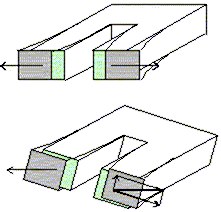

Inertial Sensors − Colibri's Micro-Gyro
A gyro is an angular rate sensor whose output signal corresponds to the speed of rotation.
There is a wide spectrum of application areas for micro-gyros including automotive (airbags, collision avoidance, anti-skid, active suspension, etc.), consumer (navigation, rehabilitation, toys, sport equipment, camera stabilization, etc.), and industrial (stabilized platforms, angular measurements, robotics, etc.). Market analyses indicated a global need year 2009 of more than 65 million high and medium quality micro-gyros. Conventional gyros, based on mechanical spinning rotors, optical fibers or laser technology are not suitable for the mass-market. Instead it is the new micromachined vibrating gyroscopes that match the large market need.
Colibri has developed and patented a micromachined gyro based on a quartz tuning fork (conference presentation (pdf)). The project was initially targeting military high-g applications. The robust component, design to cost and need, was well suited also for applications requiring large quantities of high performance micro-gyros. Licenses were granted to the German automotive industry and to the military industry. In early 2007 the patents were sold and Colibri's inertial efforts are now, under strict NDAs, fully focused on helping other companies.

Colibri's gyro is based on a micromachined tuning fork a few mm long. A reference vibration (10-50 kHz) is excited in the plane of the tuning fork with an amplitude of a few µm. The tines try to return to their original reference plane of vibration when the tuning fork, and thereby this plane, is rotated around an axis parallel to the tines. These inertial effects generate a vibration perpendicular to the plane of the tuning fork whose amplitude is proportional to the speed of rotation. Even though this amplitude is only a few percent of an atomic radius at the tip of the tines at the resolution limit it is possible to detect it since its frequency and phase are known.
Colibri's sensor element is made of crystalline quartz. This is a material well suited for this type of sensor as it is an extremely inert micromachinable piezoelectric material that enables unsurpassed signal stability over time and temperature and for which vacuum packaging is not necessary except for the toughest high-performance levels. A drawback of quartz is that it does not allow electronics to be integrated on the sensor element itself.

The production of the gyro's sensor element takes advantage of the micromachining production technology developed by the watch crystal industry. They produce six-digit quantities of watch crystals each hour at a production cost of less than $0.20 apiece, including packaging and individual laser trimming.
As for all micro-gyros, performance is determined almost entirely by how well potential error sources are handled and only to a minor degree by scale factor and noise optimization. This sets tough requirements on the gyro system, both mechanically and electrically. Important is to design to cost and need, and to include error tolerance into the design.
Typical specification for one area Colibri's gyro targeted, the automotive collision avoidance safety system, is 100°/s range, 0.3°/s long-term stability (temperature and aging), 0.05°/s short-term stability, 20Hz bandwidth, -40°C / +110°C temperature range, a shock survivability of 20,000g, and very low vibration sensitivity over a broad frequency range.
